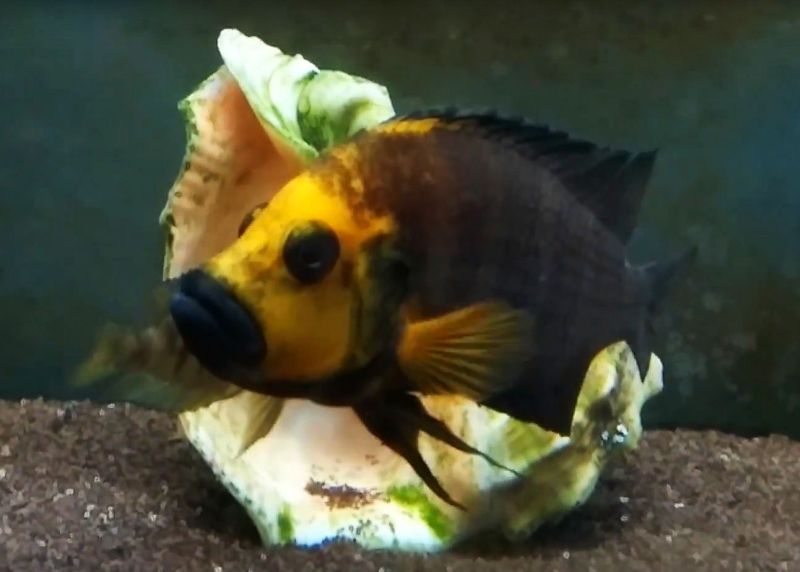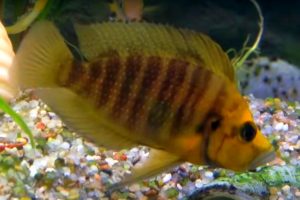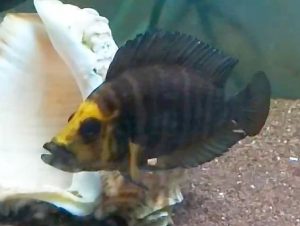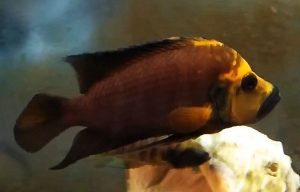The Gold Head Compressiceps (Altolamprologus compressiceps) is known to tropical fish keeping enthusiasts as the Golden Head Compressiceps, Goldhead, or Goldface Compressiceps, and is found from Malasa, Tanzania to Chituta, Zambia at the Southern end of LakeTanganyika. Most Goldenhead are collected near Mutondwe Island in Zambia.
The Gold Head Compressiceps is indigenous to Lake Tanganyika and lives in rocky areas with a mature cover of biofilm, in close proximity to sandy shell littered bottoms, at depths of 3 to 45 feet or more where they feed on invertebrates, crustaceans, small shrimp, and juvenile fish.
All Compressiceps (or Comps) are predators that specialize in ferreting out young cichlids and invertebrates from between the rocky crevices. Their laterally compressed body shape and armored scales enables them to easily get into tight, narrow, cracks in the rocks where their prey are normally hiding.
In an aquarium environment, do not keep them with fish smaller than one inch in length or with fry of other species.
Adult Gold Head Compressiceps have a laterally compressed body, a sloping forehead, a turned up snout, and yellow bodies with faint to bold black tiger like stripes and white to blue spots on the back two thirds of their flanks and a gold to yellow head.
Males are higher bodied, possess more elongated fins, are boldly colored with slightly more intense spots, and are larger than females. Females have duller colors and smaller bodies.
This species varies greatly in color pattern depending on the locality where they are collected.
Compressiceps are close relatives to Altolamprologus calvus and can be distinguished by their shorter
jaws and turned up snout. Calvus have a long sloping face, less distinct bars, and more distinct spots.
The Gold Head Compressiceps is best housed as a single pair in an aquarium of at least 55 gallon capacity decorated with numerous lava rocks piled into complex structures, and a thin layer of African Rift Lake sand or gravel substrate to cover the bottom of the tank.
In larger tanks, they can be kept in larger groups or in a community environment with other carnivorous Tanganyikan species. Avoid Tropheus and other species that require a low protein diet.
Good filtration is a necessary and a bio-wheel or wet/dry filtration system is highly recommended to maintain water quality. Weekly 50% of total volume water changes is considered mandatory for this species.
Gold Head Compressiceps are substrate spawners. In their natural habitat the female will breed in a cave or a large shell that is too small for the male to enter. Pairs form loose bonds and although the male may prefer one female over others in the tank, they are polygamous and will raise multiple families at one time.
Create several “spawning caves” or provide a pair or pairs with large sea shells large enough for the female to enter, but too small for the male.
The pair will perform their mating ritual and the female will lay anywhere from 100-200 eggs in the cave. The male does not need to enter the cave to fertilize the eggs. He will release his milt at the entrance of the cave and the pair will fan the milt inside of the cave to fertilize the eggs.
The female will stay inside the cave until the eggs hatch out, which takes about a week. When the fry are free swimming, they will eventually leave the cave on their own. The pair normally ignore the fry after they leave the protection of the cave.
Females in good condition can spawn every 25 to 35 days.
Gold Head Compressiceps fry develop very slowly and can be fed baby brine shrimp, crushed flake food, Daphnia, bloodworms, tubifex, etc. as they grow.
Although Gold Head Compressiceps will accept dry carnivore flakes or pellets in an aquarium environment, they should also be fed live, frozen, or freeze dried brine shrimp, bloodworms, mysis shrimp
, chopped earthworms, ghost shrimp, etc. Because of the potential of parasites, it is not a good idea to give them feeder fish.
Gold Head Compressiceps (Altolamprologus compressiceps) are a popular, somewhat rare Cichlid that is occasionally available online on Cichlid forums, from auction sites, direct importers, and from specialty fish shops, when they are 1″ to 1.5″ in length.
Like many species from Lake Tanganyika, a plethora of color morphs are occasionally available from retailers but the Gold Head morph which has a naturally gold head and a black body, is only found near Mutondwe Island in Zambia at the southern end of Lake Tanganyika.
Minimum Tank Size: 55 gallons
Care Level: easy
Temperament: Aggressive
Aquarium Hardiness: Moderately hardy
Water Conditions: 72-82° F, KH 10-20, pH 7.8-9.0
Max. Size: Males 5″, Females 4″
Color Form: Black, Tan, Yellow
Diet: Carnivore
Compatibility: Tanganyikan community setups
Origin: Lake Tanganyika, Africa
Family: Cichlidae
Lifespan: 8-10 years
Aquarist Experience Level: Advanced






